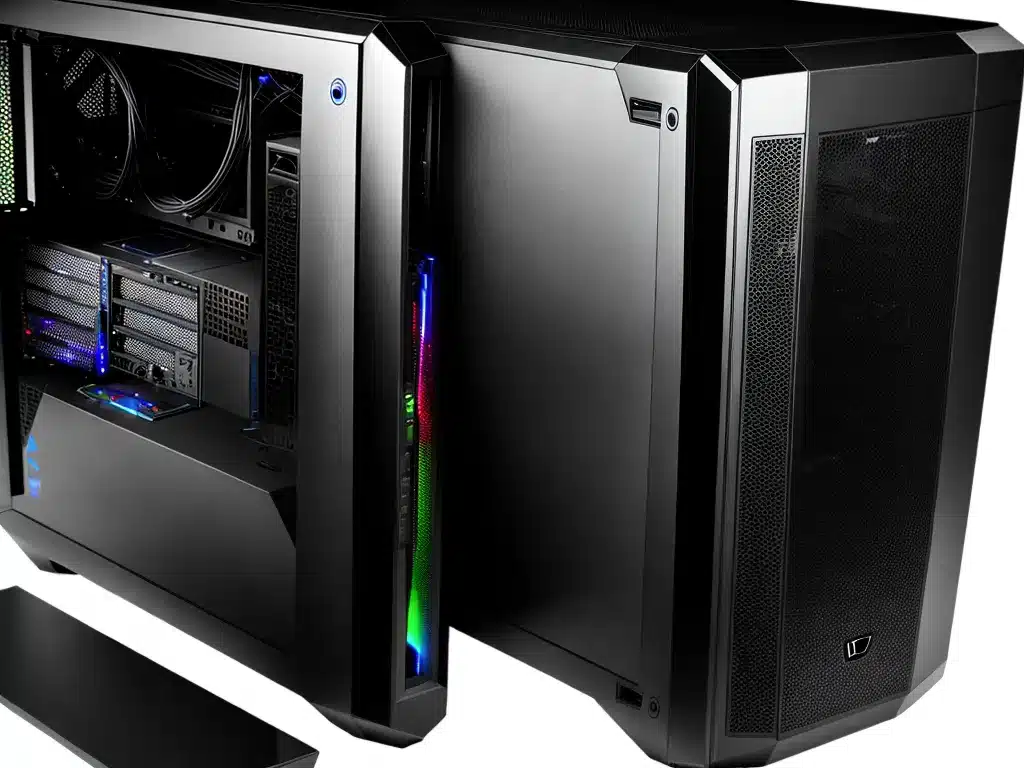
Introduction
Having proper airflow in your desktop PC case is crucial for keeping your components cool and performing at their best. In this article, I will discuss various methods and tips for maximising airflow and cooling efficiency in a desktop PC build.
Case Selection
Choosing the right PC case that promotes good airflow is the first step. Here are some things to look out for when selecting a case:
Open Design
Cases like open air or mesh-front provide maximum airflow potential. They allow unrestricted intake and hot air exhaust. Avoids issues like recycled hot air.
Fan Support
Look for cases that support multiple intake and exhaust fans of 120mm or 140mm sizes. More fan mounts provide flexibility in airflow design.
PSU Shroud
A power supply shroud helps direct airflow by isolating the PSU and drive cages. Prevents heat from these components rising into the main chamber.
Dust Filters
Intake filters prevent dust buildup inside the case. Look for magnetic and removable dust filters for easy cleaning.
Airflow Path Planning
Optimizing airflow requires directing the path properly through the case. Some tips:
Intake At Front
Front mounted intakes deliver cool air directly to CPU and GPU. Place 2-3 intake fans at front if the case supports it.
Exhaust At Back And Top
Rear and top mounted exhaust fans remove hot air efficiently. They work best in exhaust configuration.
Unobstructed Pathway
Ensure components don’t obstruct the airflow path from front intakes to rear/top exhausts.
Positive Pressure
More intakes than exhausts maintain positive pressure inside the case for minimal dust buildup.
Cable Management
Proper cable management reduces obstruction to airflow. Use ties and raceways to neatly route cables.
Fan Configuration
Choosing the right fans and configuring them properly improves airflow tremendously. Some tips:
Fan Size
120mm or 140mm fans push more air compared to smaller 80mm or 92mm fans. Bigger fans are recommended.
Higher CFM Rating
Fans with a higher CFM rating move more air. Select fans with at least 50 CFM or higher.
Fan Speed Control
Consider PWM fans that allow controlling the fan speed via BIOS or software. This offers flexibility.
Radiator Support
For liquid cooling radiators, use static pressure optimised fans. They work better with radiator fins.
Fan Curve
Configure the fan curve in BIOS so that fans ramp up at higher temperatures for better cooling.
Component Layout
Strategic placement of components promotes natural airflow in the case. Some tips:
CPU At The Front
Position the CPU cooler towards the front so that the rear exhaust draws heat away from it.
GPU At The Back
Similarly, place the graphics card closer to the rear so that front intakes blow air directly on it.
No Obstruction Between Components
Avoid placing components in between the front to back airflow path.
Memory & Drives Sideways
Position memory and drives sideways to reduce obstruction to front-rear airflow.
PSU At The Bottom
Installing the PSU at the bottom allows it to draw cool air from below the case.
Other Tips
Some other ways to improve cooling performance:
-
Use an AIO liquid cooler for CPU for best temps. Mount radiator at top exhaust.
-
Undervolt the CPU and GPU to reduce heat output.
-
Add case fans strategically if the case lacks enough.
-
Clean dust filters and fans regularly for unrestricted airflow.
-
Ensure the CPU cooler makes full contact with processor for heat transfer.
-
Cable manage behind motherboard tray to improve case airflow.
Conclusion
With some planning and the right components, you can build a PC with excellent airflow that keeps temps low. Selecting a well-ventilated case, planning the airflow path, optimal fan configuration and component layout are key factors. Following the tips outlined will help maximise cooling and allow your system to sustain peak performance.












